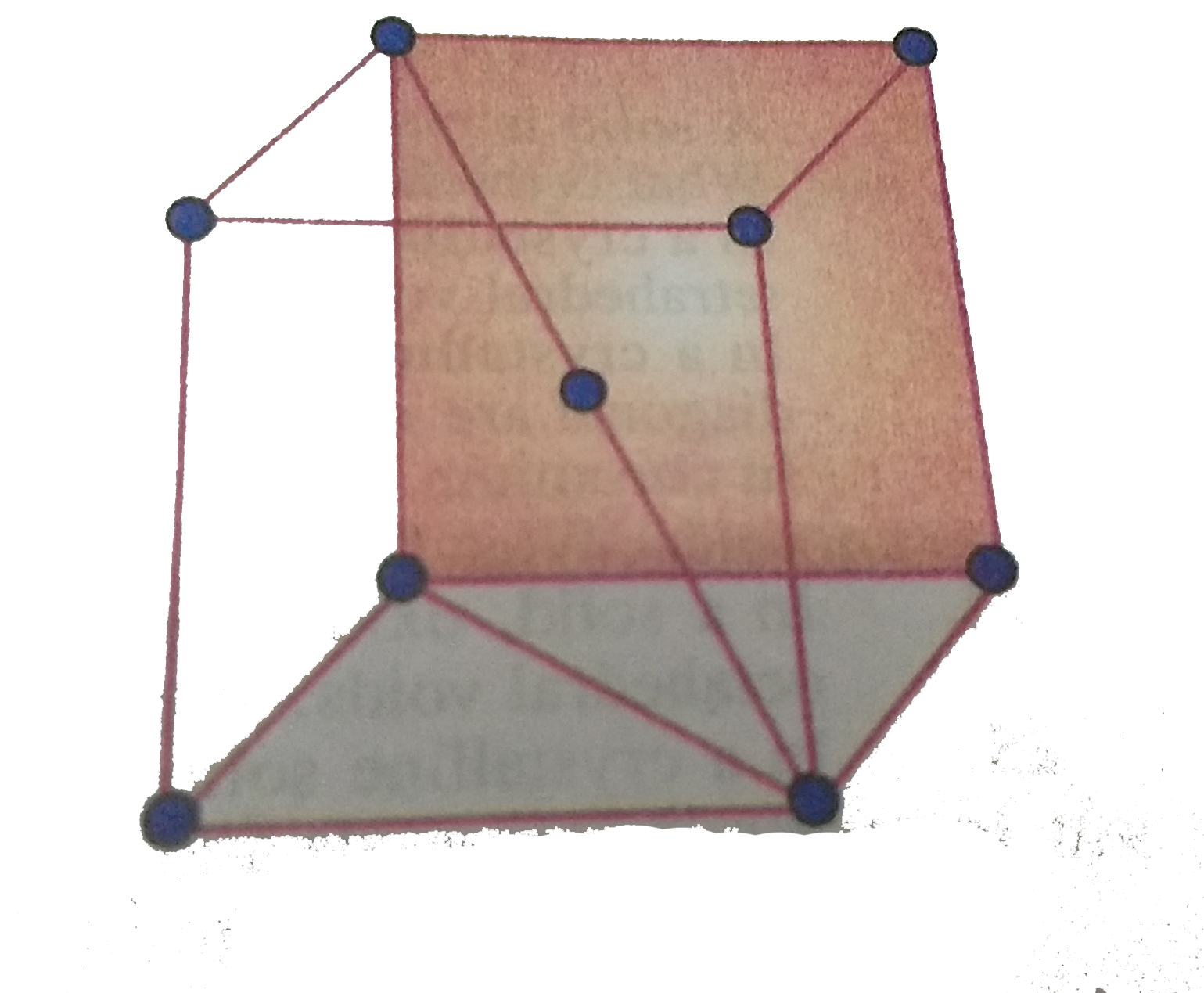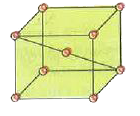Potassium crystallises in a bcc lattice as shown in figure :
(a) What is the distance the nearest neighbours ?
(b) What is the distance between the next nearest neighbours ?
(c) How many nearest neighbours does each potassium atom have ?
(d) How many next nearest neighbours does each potassium atom have ?

(a) The body diagonal is =√3a=√3×5.20Å=9.01Å
The nearest neighbours along that diagonal are at half distance apart =9.012=4.50Å
(b) The distance between the next nearest neighbours =5.20Å along the cell edge.
(c) Nearest neighbours which surround each potassium atom = 8
(d) Since the C.N. of each potassium atom is six, the next nearest neighbours which surround each potassium atom = 6.
Topper's Solved these Questions
- BOOK - DINESH PUBLICATIONCHAPTER - SOLID STATEEXERCISE - N.C.E.R.T77videos
SOLID STATE
- BOOK - DINESH PUBLICATIONCHAPTER - SOLID STATEEXERCISE - N.C.E.R.T.16videos
SOLID STATE
- BOOK - DINESH PUBLICATIONCHAPTER - REDOX REACTIONSEXERCISE - Ultimate Preparation9videos
REDOX REACTIONS
- BOOK - DINESH PUBLICATIONCHAPTER - SOLUTIONS EXERCISE - ULTIMATE PREPARATORY PACKAGE10videos
SOLUTIONS
Similar Questions
Potassium crystallizes in a body-centered cubic lattice with edge length, a = 5.2 Å
(a) What is the distance between nearest neighbours?
(b) What is the distance between next-nearest neighbours?
(c) How many nearest neighbours does each K atom have ?
(d) How many next-nearest neighbours does each K atom have ?
(e) What is the calculated density of crystalline potassium ?View SolutionAn element 'X' has bcc lattice as shown below :
The unit cell length, a is 306 pm.
(a) What is the distance between nearest neighbours?
(b) What is the distance between next nearest neighbours?
(c) How many nearest neighbours does each X atom have ?
(d) How many next nearest neighbours does each X have ?
 View Solution
View Solution
Knowledge Check
- Question 1 - Select One or More
What will be the distance between two nearest neighbours in primitive , fcc and bcc unit cell ?
AFor primitive , d=aBFor fcc, d=0.707 aCFor bcc, d=1.732 aDFor bcc , d=1.414 a - Question 2 - Select One
How many "nearst" and "next nearst" neighbours, respectively, does potassium have in bcc lattice?
A8,8B8,6C6,8D6,6 - Question 3 - Select One
Ar crystallizes in an F.C.C. lattice . If the unit cell length is 5.311A∘. find the distance between nearest neighbours.
A5.311A∘B3.75A∘C6.25A∘D7.33A∘
Potassium crystallizes in body centered cubic lattice with a unit cell length a=5.2Å
(A) what is the distance betweenn nearest neighbourss?
(B) What is the distance between next nearest neighbour ?
(C) How many nearest neighbours does each K atom have ?
(D) How many next nearest neighbours does each K has ?
(E) What is calculated density of crystalline KView SolutionLithium crystallizes in a body centred cubic lattice. How many next-nearest neighbours does each Li have?
View SolutionPlatinum crystallize in a face-centred cubic crystal with a unite cell length a. the distance between nearest neighbours is:
View SolutionPotassium crystallizes in bcc unit cell with distance nearest neighbours of 4.52 Å, if its atomic mass = 39 amu.
(a)What would be edge length of unit cell ?
(b)What would be the density of K metal ?
(c ) How many nearest neighbouring atoms does each potassium atom has ?View SolutionHow many nearest neighbours surrounded each particle in a face-centred cubic lattice?
View Solution
